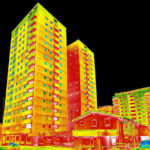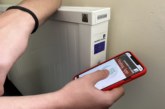 For the second in a new regular series covering drone technology, Ray Faulkner, Managing Director of iRed®, offers advice on how to maximise your zero carbon budget with thermal imaging drones.
For the second in a new regular series covering drone technology, Ray Faulkner, Managing Director of iRed®, offers advice on how to maximise your zero carbon budget with thermal imaging drones.
With the diverse nature of local authorities’ roles as place shapers, planners and trusted leaders who have influence across a range of carbon emitting sectors, decarbonising the existing housing stock is vital to achieving net zero, initially by improving their energy efficiency followed by switching to low carbon heating. With ever increasing energy prices all heat loss saved from buildings has a positive financial and social impact on occupiers.
Following the UK Government’s significant pledge of £9.3bn to fund the retrofitting of buildings in England by 2024, the pressure is on local authorities to improve their buildings, reduce carbon emissions and maximise their zero carbon budgets.
Drone thermal imaging is a technique that uses heat-sensitive cameras to detect subtle differences in temperature, providing a non-destructive assessment of heat loss in both residential and commercial buildings. Knowing where heat is escaping from means those responsible, such as sustainability officers and project managers, can take steps to improve energy efficiency, reduce heating costs and cut carbon emissions.
Pinpointing areas for improvement
Whilst traditional surveys from retrofit assessors can provide an indication of required works, thermal surveys provide a clearer, more accurate picture of what’s happening in a building or property portfolio. Using the latest technology, drone surveys are able to accurately pinpoint areas for improvement — such as missing, damaged, or faulty insulation — as well as being able to monitor the effectiveness of any remedial works. This means that any performance gaps, such as buildings that haven’t been built as designed, can be identified and corrected. The easy-to-understand reports help visualise heat loss and building defects, providing quantitative data that can be easily communicated to both residents and non-building professionals.
These quick and non-disruptive inspections are the easiest way to prioritise retrofitting works, and provide minimal disruption to residents and occupiers of non-residential buildings. They can even be used to clearly demonstrate improvements following remedial works.
Since 2002, we’ve been working with councils and housing associations nationwide, delivering over half a million thermal surveys on domestic and commercial buildings. In that time, we’ve seen clients save thousands on their heating bills by simply showing them how to get the best results for the smallest spend.
Accurate information
When delivered by qualified professionals, a drone thermal imaging survey will provide comprehensive evidence to assist in publishing tenders, tailored to specific property and building types. This can help drastically reduce the average retrofit cost, by showing exactly where the problems are and enabling contractors to quote with pinpoint accuracy.
Ray adds: “Previously, these types of surveys would’ve been done with expensive scaffolding, requiring the risk of working at height along with a significant disruption to occupiers. Now, using drone technology, we’re able to survey hundreds of properties in a single night.”
In the UK, the cost of retrofitting a typical household is approximately £26,000 (Committee on Climate Change). Combine this with the fact that there are an estimated 26 million homes requiring retrofits before 2050 (The Institution of Engineering and Technology), and the cost of achieving net zero in the built environment is staggering. By accurately finding out where they’re losing heat, councils, housing associations and local authorities could potentially save billions of pounds by including thermal drone surveys into their retrofit strategy.
For more information on ARPASUK visit www.arpas.uk
For more information on Connected Places Catapult visit https://cp.catapult.org.uk/
For more information on iRed® visit https://ired.co.uk/









